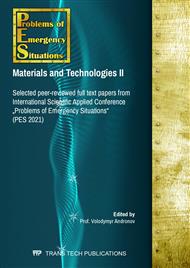[1]
Kustov, M., Slepuzhnikov, E., Lipovoy, V., Firdovsi, D.I., Buskin, O. Procedure for implementation of the method of artificial deposition of radioactive substances from the atmosphere. Nuclear and Radiation Safety, 3(83) (2019) 13–25.
DOI: 10.32918/nrs.2019.3(83).02
Google Scholar
[2]
Bertik, A., Zimmerman, W., Pitt, M., Strizik, M., Nevrly, V., & Zelinger, Z. Modelling accidental releases of dangerous gases into lower troposphere from mobile sources. Process Safety and Environment Protection, 86 (2008) 198-207.
DOI: 10.1016/j.psep.2007.12.002
Google Scholar
[3]
Charles McLean, Y. Tina Lee, Sanjay Jain, Charles Hutchings. Modeling and Simulation of Hazardous Material Releases for Homeland Security Applications. National Institute of Standards and Technology, (2011) 68.
DOI: 10.6028/nist.ir.7786
Google Scholar
[4]
Shiraiwa M., Pfrang C., Koop T., Pöschl U. Kinetic multi-layer model of gas-particle interactions in aerosols and clouds (KM-GAP): linking condensation, evaporation and chemical reactions of organics, oxidants and water. Atmos. Chem. Phys. 12 (2012) 2777–2794.
DOI: 10.5194/acp-12-2777-2012
Google Scholar
[5]
Takaharu T., Tsuruta T., Nagayama G. Molecular Dynamics Studies on the Condensation Coefficient of Water. J. Phys. Chem. B. 108(5) (2004) 1736–1743.
DOI: 10.1021/jp035885q
Google Scholar
[6]
Julin J., Shiraiwa M., Miles R., Reid J.P., Pöschl U., Riipinen I. Mass Accommodation of Water: Bridging the Gap Between Molecular Dynamics Simulations and Kinetic Condensation Models. J. Phys. Chem. A. 117 (2013) 410 − 420.
DOI: 10.1021/jp310594e
Google Scholar
[7]
A. Da˛browski. Adsorption from theory to practice. Advances in Colloid and Interface Science, 93 (2001) 135-224.
Google Scholar
[8]
Compilation of Henry's Law Constants for Inorganic and Organic Species of Potential Importance in Environmental Chemistry. URL: http://www.henrys-law.org/henry-3.0.pdf.
Google Scholar
[9]
State sanitary standards for the protection of atmospheric air of populated areas (from pollution by chemical and biological substances) DSP 201-97. Valid from 1997-07-09. The Order of the MOH of Ukraine No. 201. 43 p.
Google Scholar
[10]
Zeng, Y.; Fan, C.; Do, D. D.; Nicholson, D. Condensation and Evaporation in Slit-Shaped Pores: Effects of Adsorbate Layer Structure and Temperature, J Phys Chem C. 118 (2014) 3172-3180.
DOI: 10.1021/jp412376w
Google Scholar
[11]
Sugata P. Tan* and Mohammad Piri. Modeling the Solubility of Nitrogen Dioxide in Water Using Perturbed-Chain Statistical Associating Fluid Theory. Ind. Eng. Chem. Res., 52 (2013) 16032−16043.
DOI: 10.1021/ie402417p
Google Scholar
[12]
Winkler P.M., Vrtala A., Wagner P.E., Kulmala M. and other. Mass and Thermal Accommodation during Gas-Liquid Condensation of Water. Phys. Rev. Lett. 93 (2004) 075701 – 075723.
DOI: 10.1103/physrevlett.93.075701
Google Scholar
[13]
Davidovits P., Kolb C.E., Williams L.R. and other. Mass Accommodation and Chemical Reactions at Gas−Liquid Interfaces. Chem. Rev. 106 (4) (2006) 1323 – 1354.
DOI: 10.1021/cr040366k
Google Scholar
[14]
Kolb C. E., Cox R. A., Abbatt J.P., Ammann M. and other. An overview of current issues in the uptake of atmospheric trace gases by aerosols and clouds. Atmos. Chem. Phys. 10 (2010) 10561-10605.
DOI: 10.5194/acp-10-10561-2010
Google Scholar
[15]
Gilde A., Siladke N., Lawrence C. P. Molecular Dynamics Simulations of Water Transport through Butanol Films. J. Phys. Chem. A. 113(30) (2009) 8586–8590.
DOI: 10.1021/jp9026699
Google Scholar


